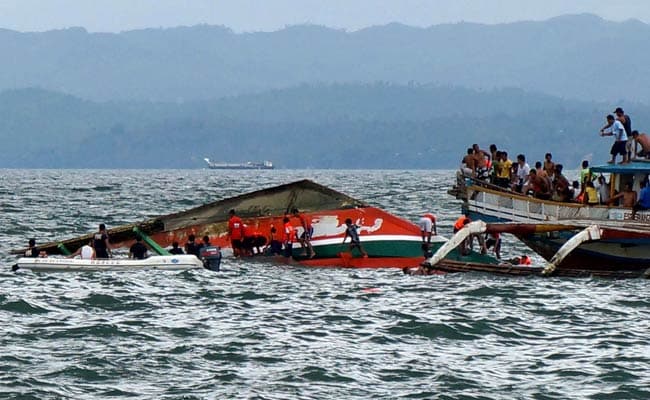
Rescuers search for survivors at the site of the capsized passenger ferry off Ormoc City, central Philippines on July 2, 2015. (Agence France-Presse)
Ormoc City, Philippines:
The death toll from a ferry that capsized in the central Philippines has risen to 61, the coast guard has said today, indicating that the vessel was overloaded.
Whether the ferry was carrying too many people will be part of an investigation into last week's disaster off the city of Ormoc, which has seen the boat's owner and crew charged with murder.
Coast guard figures showed that 61 people had died when the wooden Kim Nirvana capsized, with at least 145 people listed as survivors.
This would mean at least 206 people were on-board, exceeding the 194 passengers and crew the boat was authorized to carry.
The heavy cargo the ferry was transporting may also have played a role, authorities have said.
"The number of bodies is more than we expected," said Captain Pedro Tinampay, the regional coast guard chief, refusing to speculate how many might still be missing.
Only 173 passengers and 16 crew were listed on the boat's manifest.
The crew have been accused of reckless behavior, with an initial police investigation and interviews with survivors indicating the vessel turned abruptly causing it to capsize.
The police investigation is separate from a coast guard enquiry, which will primarily determine the cause of the mishap. However, the coast guard may also recommend criminal and administrative charges.
On Sunday, a coast guard search and rescue vessel transported the bodies of 42 residents of Camotes - where the ferry had been heading - back to their island home for burial.
Relatives watched gravely as rescue personnel carried dozens of white coffins onto the ship.
The Kim Nirvana, which has been lifted out of the water with a crane, lay on a ramp in the background.
As well as passengers the boat had also been transporting sacks of cement, rice and fertilizer which would have weighed as much as 7,500 kilos.
Poorly-maintained, loosely-regulated ferries form the backbone of maritime travel in the Philippines, a sprawling archipelago of 100 million people.
Frequent accidents involving overloaded ferries in recent decades have claimed thousands of lives, including the world's worst peacetime maritime disaster in 1987 when the Dona Paz ferry collided with an oil tanker, leaving more than 4,300 dead.
Whether the ferry was carrying too many people will be part of an investigation into last week's disaster off the city of Ormoc, which has seen the boat's owner and crew charged with murder.
Coast guard figures showed that 61 people had died when the wooden Kim Nirvana capsized, with at least 145 people listed as survivors.
This would mean at least 206 people were on-board, exceeding the 194 passengers and crew the boat was authorized to carry.
The heavy cargo the ferry was transporting may also have played a role, authorities have said.
"The number of bodies is more than we expected," said Captain Pedro Tinampay, the regional coast guard chief, refusing to speculate how many might still be missing.
Only 173 passengers and 16 crew were listed on the boat's manifest.
The crew have been accused of reckless behavior, with an initial police investigation and interviews with survivors indicating the vessel turned abruptly causing it to capsize.
The police investigation is separate from a coast guard enquiry, which will primarily determine the cause of the mishap. However, the coast guard may also recommend criminal and administrative charges.
On Sunday, a coast guard search and rescue vessel transported the bodies of 42 residents of Camotes - where the ferry had been heading - back to their island home for burial.
Relatives watched gravely as rescue personnel carried dozens of white coffins onto the ship.
The Kim Nirvana, which has been lifted out of the water with a crane, lay on a ramp in the background.
As well as passengers the boat had also been transporting sacks of cement, rice and fertilizer which would have weighed as much as 7,500 kilos.
Poorly-maintained, loosely-regulated ferries form the backbone of maritime travel in the Philippines, a sprawling archipelago of 100 million people.
Frequent accidents involving overloaded ferries in recent decades have claimed thousands of lives, including the world's worst peacetime maritime disaster in 1987 when the Dona Paz ferry collided with an oil tanker, leaving more than 4,300 dead.
Track Latest News Live on NDTV.com and get news updates from India and around the world

